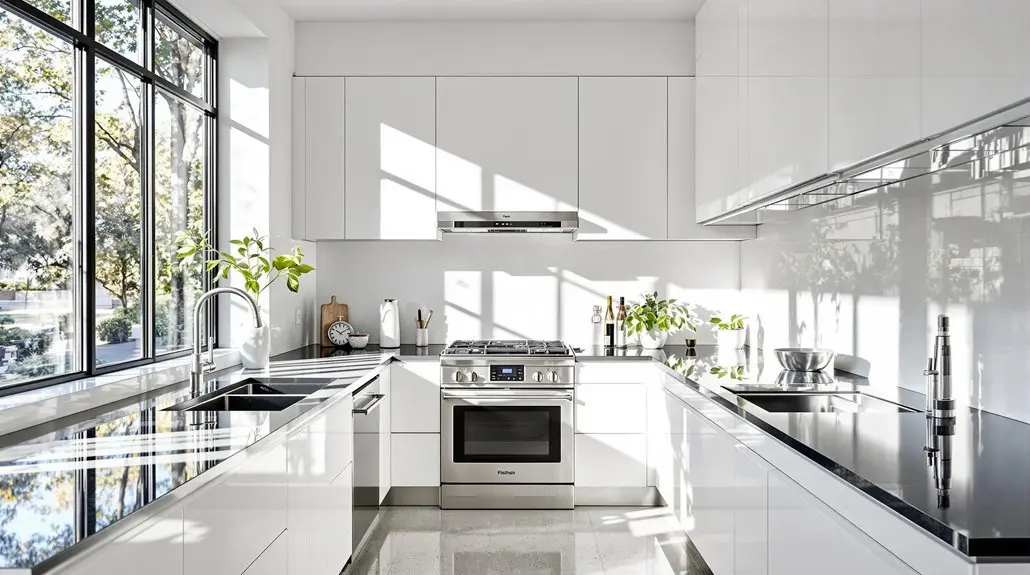
14 White Kitchen With Black Countertops for a High-Contrast Look
A white kitchen with black countertops epitomizes high-contrast design by blending crisp cabinetry with bold, grounding surfaces. Classic white cabinets and black granite offer timeless appeal, while off-white tones and gold accents soften the aesthetic. Glossy finishes, patterned backsplashes, and natural wood add visual layers, balancing tradition and modernity. Strategic lighting and metallic hardware guarantee both function and elegance. The following examples showcase nuanced ways to enhance this striking design framework even further.
Key Takeaways
- Classic white or off-white cabinets paired with black granite or quartz countertops create a timeless, high-contrast look ideal for both modern and traditional kitchens.
- Incorporate gold, black, or brushed nickel hardware to add sophistication and unify the high-contrast design.
- Layer textures and patterns with matte cabinet finishes, glossy countertops, and patterned backsplashes for added depth and visual interest.
- Use natural wood accents, greenery, and ample natural light to soften the stark contrast and infuse warmth into the kitchen space.
- Contrasting kitchen islands in bold colors or different materials create focal points and enhance the dynamic visual appeal.
Classic White Cabinets With Sleek Black Countertops
When classic white cabinetry is juxtaposed with sleek black countertops, the resulting visual contrast establishes a sophisticated and timeless aesthetic within the kitchen. This striking contrast not only highlights the architectural lines of white cabinets but also creates a focal point that grounds the overall design. In a modern kitchen context, black countertops—crafted from materials such as granite or quartz—introduce depth and a sense of elegant sophistication. The interplay between these opposing tones allows for a versatile backdrop, accommodating both minimalist and traditional design approaches. Integration of black hardware further amplifies the cohesive, high-contrast look. Beyond its visual impact, this pairing promotes a bright and airy atmosphere, reflecting light while maintaining visual interest. Such thoughtful combinations remain a preferred choice among discerning homeowners. Additionally, incorporating gold hardware can introduce a touch of luxury and refinement, enhancing the elegance of the space without overwhelming it.
Warmth and Charm With Off-White Cabinets
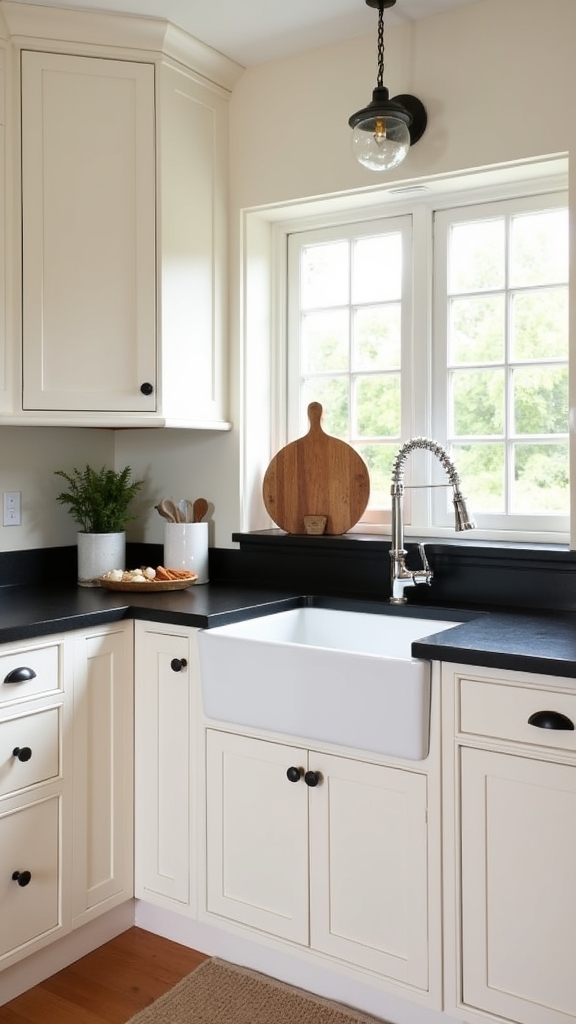
While crisp white cabinetry and black countertops offer a classic, high-contrast statement, opting for off-white cabinets introduces a layer of warmth and nuanced charm to the composition.
The subtle creamy undertones of off-white cabinets soften the visual intensity of black countertops, yielding a warm and inviting atmosphere that enhances the kitchen’s overall comfort. This pairing creates a sophisticated contrast, lending depth and visual intrigue to the design scheme.
Strategic use of black knobs and pulls on off-white cabinets maintains cohesion, while dark hardwood flooring amplifies the charm with additional texture and richness.
Complementary wall colors—such as a soft goose-yellow—further enhance the welcoming ambiance, ensuring the space feels cheerful and approachable.
Incorporating sustainable materials in your kitchen design not only aligns with eco-friendly trends but also adds another layer of warmth and organic feel to the space.
This harmonious interplay of materials and tones exemplifies effective kitchen design principles.
Timeless Appeal of Shaker Cabinets and Black Granite
Though rooted in historical tradition, Shaker cabinets exhibit a clean-lined simplicity that seamlessly complements the enduring elegance of black granite countertops. This pairing delivers a high-contrast look that embodies timeless appeal and raises any kitchen with a sophisticated look. The crisp geometry of Shaker cabinets enhances the visual dynamism of deep, lustrous black granite, creating a focal point that is both functional and aesthetically enduring. Black granite’s resilience against heat and scratches further underscores its practical synergy with the durable construction of Shaker cabinets. Lighter or medium shades of grey enhance the sleekness of black appliances, further enriching the overall kitchen design. The following table illustrates key design principles and benefits:
| Design Principle | Benefit |
|---|---|
| High-Contrast Look | Visual depth and striking focal point |
| Timeless Appeal | Adaptable to evolving decor trends |
| Sophisticated Look | Enhances perceived value and elegance |
Modern Minimalist Kitchen Design

Modern minimalist kitchen design is defined by the use of sleek, handleless white cabinetry that establishes a seamless and uncluttered visual flow. High-gloss black countertops introduce a bold contrast, reinforcing a sense of sophistication through reflective surface interplay. This juxtaposition emphasizes geometric purity and highlights the kitchen’s architectural lines. Incorporating industrial accents like stainless steel appliances enhances sophistication and visual interest.
Sleek Handleless Cabinetry
Sleek handleless cabinetry defines the minimalist ethos in contemporary kitchen design, emphasizing uninterrupted lines and a seamless visual flow. By eliminating traditional hardware, this cabinetry style enhances the modern minimalist aesthetic, promoting an uncluttered environment.
The use of push-to-open mechanisms or integrated handles preserves the cabinetry’s smooth surfaces, ensuring both function and visual appeal. High-quality materials, such as MDF or plywood, are commonly utilized, with finishes in matte or glossy whites that complement the striking presence of black countertops.
This creates a dynamic interplay of high-contrast elements—bright white cabinets set against deep black countertops—amplifying spatial perception and modernity. Integrated lighting within handleless cabinetry further accentuates the sleek appearance, drawing attention to the deliberate contrast central to high-end minimalist kitchen design.
High-Gloss Countertop Finishes
Building on the foundation of handleless cabinetry, high-gloss black countertops introduce a reflective surface that intensifies both brightness and contrast within a minimalist kitchen.
The polished sheen of these black countertops, often crafted from durable materials such as quartz or granite, not only imparts a sleek aesthetic but also enhances spatial depth.
When juxtaposed with matte or semi-gloss white cabinets, the high-gloss finish delivers a striking visual interplay, reinforcing a modern look rooted in high-contrast design principles.
This reflective quality amplifies natural light, contributing to an open, airy atmosphere—a hallmark of contemporary minimalism.
Maintaining the pristine surface of high-gloss countertops requires regular, gentle cleaning to preserve their luster, ensuring the kitchen consistently embodies a refined and cohesive modern aesthetic.
Layering Textures and Patterns for Depth
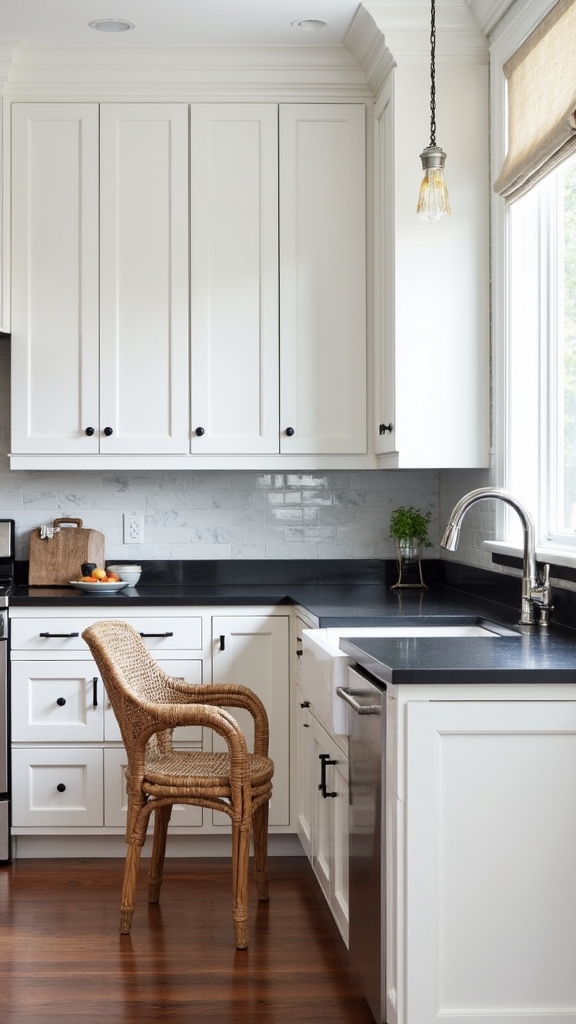
Strategic layering of contrasting materials and finishes, such as matte cabinet hardware against glossy black countertops, enhances tactile and visual interest within a white kitchen. Patterned backsplashes, like herringbone black tiles, and varied flooring selections introduce rhythmic movement and complexity to the design. These elements collectively contribute to a balanced interplay of depth and dimension in the kitchen environment. The natural warmth of butcher block adds a welcoming atmosphere, complementing the starkness of black countertops and enriching the overall aesthetic appeal of the kitchen.
Contrasting Materials and Finishes
Visual contrast becomes a defining feature in white kitchens with black countertops when designers layer diverse materials and finishes.
Contrasting materials—such as smooth black countertops against matte finish white cabinets—establish a sophisticated interplay of light and shadow, elevating the kitchen’s visual interest.
Layered textures, from the sleek surface of black granite to the tactile appeal of open wooden shelves, prevent monotony while enhancing spatial depth.
The integration of matte finish cabinetry juxtaposed with the luster of glossy countertops further accentuates the high-contrast design ethos, providing a contemporary edge.
Subtle introductions of woven or textile accessories serve to soften the stark palette, creating visual warmth and balance.
This strategic curation of materials and finishes results in a kitchen that is both dynamic and cohesive.
Patterned Backsplashes and Flooring
Beyond the interplay of contrasting materials and finishes, the introduction of patterned backsplashes and flooring adds another layer of depth to white kitchens with black countertops.
Patterned backsplashes—such as herringbone, geometric, or mosaic motifs—establish visual rhythm, complementing the high-contrast look between cabinetry and countertops. The use of textured tiles, whether matte or glossy, further enriches the surface quality, amplifying dimension and tactile appeal.
On the floor, classic black and white checkered patterns or intricate designs reinforce the color palette while grounding the space. Layering these patterns across backsplashes and flooring supports a cohesive design, ensuring each element harmonizes within the overall scheme.
Selecting complementary colors and textures in these finishes unifies the aesthetic and enhances the kitchen’s architectural interest.
Incorporating Natural Wood and Greenery
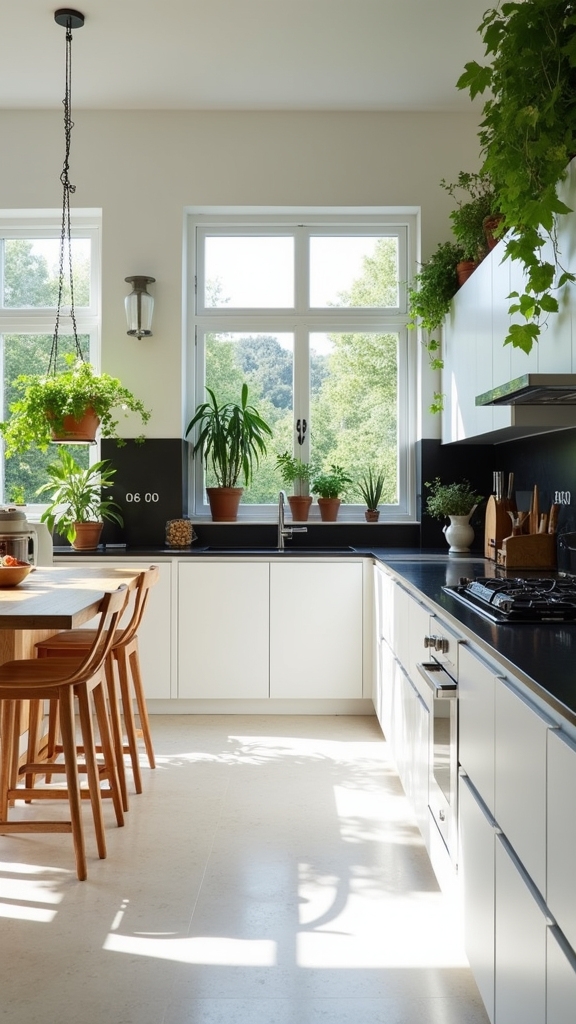
How can warmth and organic texture be achieved in a white kitchen with black countertops? Integrating natural wood accents provides a tactile counterbalance to the crispness of white cabinetry and the boldness of black countertops. Elements such as wooden open shelving or butcher block accessories introduce both function and visual appeal, softening the high-contrast palette. Greenery, in the form of potted plants or fresh herb gardens, infuses the space with energy and color, further enhancing the welcoming ambiance. Varying plant heights and leaf textures amplify visual interest, harmonizing with the kitchen’s sleek lines. Incorporating reclaimed wood in cabinetry or shelving can add unique grain patterns and weathered textures, enhancing the rustic charm and authenticity of the space. The table below demonstrates the interplay of these elements:
| Element | Function | Visual Impact |
|---|---|---|
| Wood Shelves | Storage & Warmth | Softens contrasts |
| Potted Greenery | Color & Freshness | Adds organic texture |
| White Cabinetry | Backdrop & Brightness | Highlights accents |
| Black Countertops | Modern Edge | Grounds the palette |
Bright and Cozy Spaces With Black Soapstone
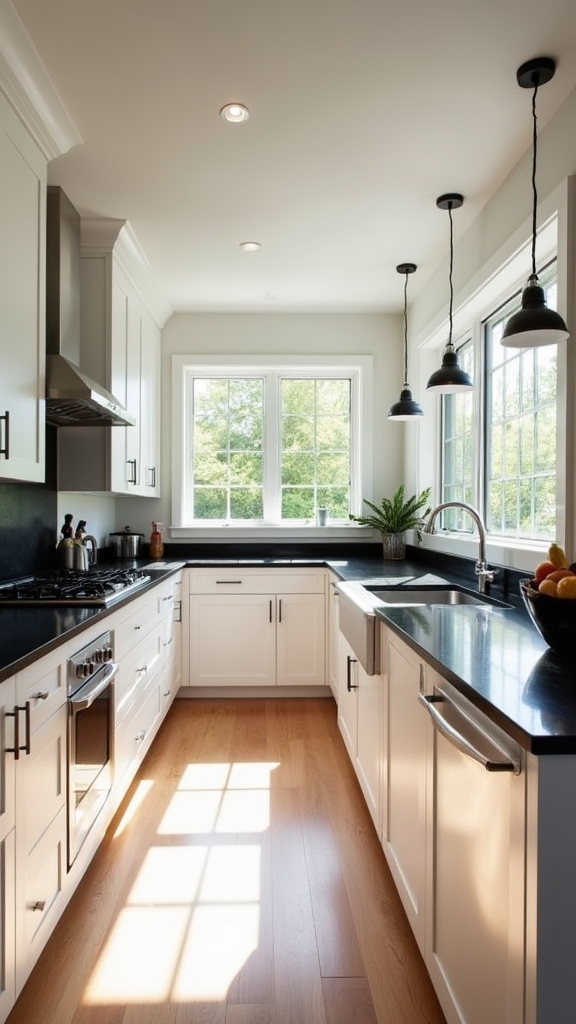
Maximizing natural light is essential when pairing black soapstone countertops with white cabinetry, as it enhances spatial brightness and visually balances the dark surfaces. Thoughtful integration of inviting decorative accents—such as textured textiles, warm metallics, or organic ceramics—introduces tactile contrast and visual interest. This design approach fosters a harmonious environment that is both luminous and welcoming. Incorporating gold pendant lighting introduces luxury and functionality, enhancing both ambient and task lighting while serving as central focal points.
Maximizing Natural Light
When natural light is thoughtfully integrated into a white kitchen with black soapstone countertops, the interplay of brightness and contrast produces a space that feels expansive and inviting.
Maximizing natural light is fundamental in white kitchen design, as it counters the visual weight of black countertops and amplifies spatial perception. Large windows and open floor plans facilitate the influx of daylight, guaranteeing the kitchen remains bright rather than somber.
Reflective surfaces—such as high-gloss cabinetry or strategically placed mirrors—further disperse light, enhancing the luminous quality of the room. Selecting lighter wall hues and decor to create warmth and character complements the boldness of black countertops without diminishing coziness.
Thoughtful arrangement of vibrant plants or colorful accents guarantees the kitchen retains both visual balance and welcoming ambiance.
Inviting Decorative Accents
Although black soapstone countertops introduce a striking visual anchor within a white kitchen, the careful selection of decorative accents is crucial for achieving a harmonious and inviting environment.
Strategic decorative elements—such as vivid floral arrangements and colorful kitchenware—provide dynamic contrast, enlivening the interplay between black countertops and white cabinets.
Soft under-cabinet lighting accentuates the nuanced texture of soapstone, infusing the space with a warm ambiance while enhancing visual depth.
Incorporating light-toned details, such as pastel wall treatments or pale wooden shelving, further raises brightness and mitigates any potential starkness.
The introduction of natural materials, including woven baskets and organic textiles, contributes both tactile interest and warmth, balancing the boldness of the countertops.
This approach guarantees a cohesive, welcoming kitchen aesthetic defined by both sophistication and comfort.
Elegant Accents With Gold Hardware
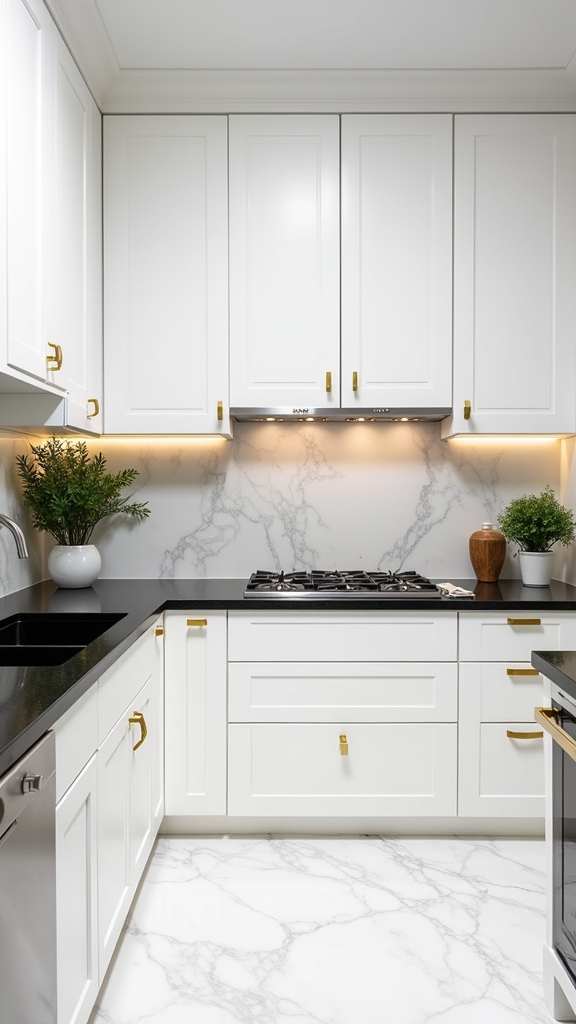
Gold hardware introduces a layer of refined sophistication to white kitchens with black countertops, utilizing contrast and material interplay to striking effect.
When applied to white cabinets, gold hardware—such as knobs and cup pulls—creates elegant accents that punctuate the high-contrast look of the space. The warm metallic sheen of gold elegantly offsets the cool, sleek surface of black countertops, enhancing visual interest and depth.
As a focal point, gold hardware imparts a sense of luxury and opulence, reinforcing a polished aesthetic. Coordinating gold fixtures, including faucets and lighting, further unifies the design for cohesive impact.
Opting for matte or brushed finishes can soften the overall ambiance, ensuring the interplay between white, black, and gold remains balanced and visually harmonious within the kitchen environment. The fusion of black and gold creates sophistication and opulence, making a bold statement in kitchen design.
Color Matching With Contrasting Kitchen Islands
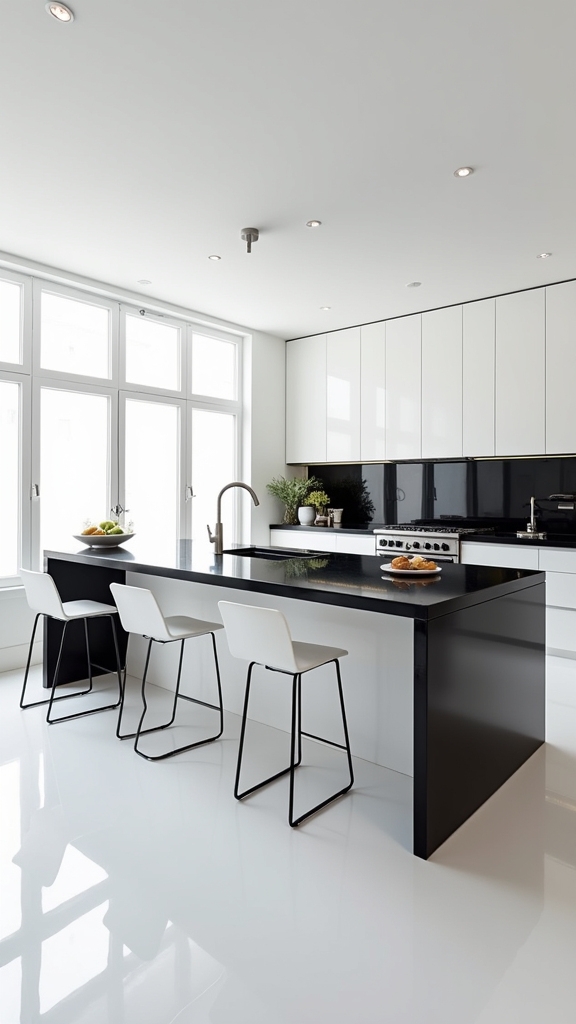
A contrasting kitchen island introduces a deliberate layer of visual intrigue within white kitchens anchored by black countertops. Selecting bold hues, such as deep blue or emerald green, for the island creates a striking focal point, enhancing the interplay between white cabinetry and dark surfaces. Effective color matching extends beyond the island—echoing its shade through bar stools or decorative accents cultivates cohesion within the high-contrast environment. Employing a white marble countertop atop the island bridges the visual gap between the black countertops and white cabinetry, reinforcing the sophisticated palette. Opting for a matte finish on island cabinetry versus a glossy main finish introduces tactile variety, while open shelving on the contrasting kitchen island allows for curated color displays, further intensifying visual depth and vibrancy. Incorporating elegant navy blue as a kitchen island color can provide a timeless sophistication that enhances the overall aesthetic.
Simple and Functional Aesthetics
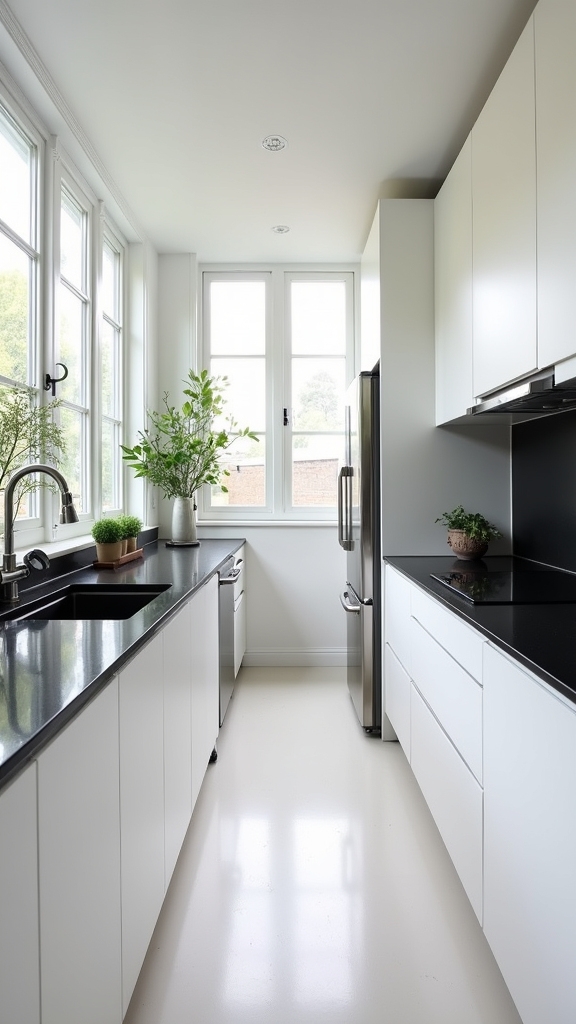
Building upon the dynamic interplay introduced by contrasting kitchen islands, simple and functional aesthetics in a white kitchen with black countertops prioritize clarity of form and purposeful design.
The use of white cabinets with black countertops establishes a foundation of high-contrast visual impact, emphasizing clean lines and a modern appearance. Matte finishes and sleek surfaces, such as black granite or quartz, reinforce simple aesthetics while maintaining durability and function.
Open shelving in wood or metal offers practical storage without disrupting the minimalist atmosphere, contributing to both visual lightness and accessibility. Hardware choices—brushed nickel or matte black pulls—are deliberately understated, ensuring the striking contrast remains the focal point.
Greige cabinetry offers practical storage solutions, with easy maintenance and cleaning due to light-colored surfaces. This approach allows for the seamless integration of accent pieces, supporting a cohesive yet adaptable kitchen environment.
Balancing Traditional and Contemporary Elements

A white kitchen with black countertops provides a dynamic framework for mixing vintage influences with modern sensibilities.
Strategic use of contrasting colors, varied textures, and thoughtfully selected accents achieves a seamless blend of old and new.
This approach results in a visually compelling space that balances timeless elegance with contemporary edge.
Mixing Vintage and Modern
While integrating vintage and modern elements in a white kitchen with black countertops, designers often emphasize the importance of balanced contrast and visual harmony. The interplay between vintage accessories—such as antique-style lighting or farmhouse sinks—and sleek modern elements like high-gloss black countertops produces a curated, layered aesthetic.
Traditional Shaker-style cabinets serve as a grounding feature, their classic profiles juxtaposed against contemporary hardware and minimalist décor for a sophisticated blend of old and new. Vintage wooden shelves displaying modern kitchenware accentuate the contrast between eras, establishing a visually engaging focal point.
Patterned tiles or retro bar stools, when paired with modern appliances, reinforce the eclectic kitchen space while maintaining cohesion. This nuanced approach guarantees the kitchen feels intentional, unified, and visually dynamic without sacrificing functional efficiency.
Harmonizing Colors and Textures
By thoughtfully juxtaposing color and texture, a white kitchen with black countertops achieves a dynamic equilibrium between traditional and contemporary design elements. The contrast of white cabinets with black countertops acts as a bold visual anchor, while the interplay of matte and glossy surfaces introduces depth and tactile variety. Harmonizing colors through strategic accents—such as dark metal hardware or patterned textiles—bridges the aesthetic divide, ensuring a seamless shift between styles. The integration of wooden textures, like open shelving or butcher block islands, infuses the space with organic warmth, further balancing the modern finishes.
| Feature | Traditional Element | Contemporary Element |
|---|---|---|
| Cabinet Finish | Matte White Cabinets | Glossy Black Countertops |
| Hardware | Ornate Handles | Sleek Dark Metal |
| Accents | Wooden Shelves | Patterned Textiles |
Blending Old With New
Careful integration of traditional and contemporary elements defines the visual harmony in a white kitchen with black countertops. The juxtaposition of white cabinets with sleek black countertops creates a striking contrast, underscoring both heritage and innovation.
Design professionals often employ the following strategies to achieve a seamless balance:
- Mixing Materials: Pairing shaker-style white cabinets and rustic wooden shelves with glossy black countertops merges traditional elements with modern features for curated depth.
- Linking Details: Decorative accents—such as brass or gold hardware—act as connecting elements, infusing elegance while linking classic and current design vocabularies.
- Layering Surfaces: Incorporating subway tile backsplashes and contemporary fixtures further enhances the kitchen’s visual complexity, emphasizing both contrast and cohesion.
Through these principles, designers expertly blend old with new, achieving a sophisticated, high-contrast kitchen aesthetic.
Clean Lines With Glossy Finishes
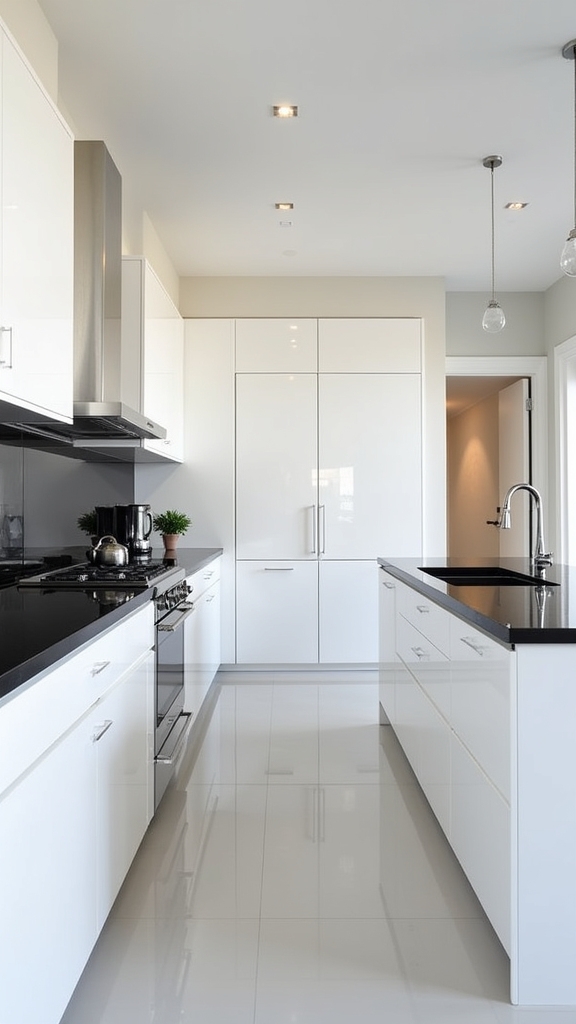
A multitude of modern kitchens achieve visual impact through the interplay of clean lines and glossy finishes, especially when crisp white cabinetry is juxtaposed with sleek black countertops.
The high-reflectivity of glossy finishes on white cabinets amplifies natural and artificial light, enhancing openness while contributing visual depth. Clean lines—often realized with handle-less or slab-front cabinetry—reinforce a minimalist aesthetic, aligning seamlessly with the streamlined look of black countertops.
The continuity of glossy surfaces across both cabinetry and countertops not only unifies the overall design framework but also promotes maintenance, as their smooth textures minimize dust and residue accumulation.
This sophisticated combination of elements guarantees adaptability across various styles, from contemporary to transitional, positioning the kitchen as an architectural focal point defined by clarity, contrast, and refined simplicity.
Overcoming Common Challenges of Black Countertops

While the interplay of clean lines and glossy finishes enhances the aesthetic appeal of a white kitchen with black countertops, certain practical considerations must be addressed to optimize functionality and preserve visual harmony.
Black countertops, though striking, present unique challenges related to light absorption, maintenance, and thermal properties. Designers can mitigate these issues by:
- Strategically positioning lighting fixtures to counteract the light-absorbing nature of black surfaces, guaranteeing the space remains bright and inviting.
- Selecting matte black finishes to reduce the visibility of dust, smudges, and fingerprints, thereby streamlining everyday maintenance.
- Acknowledging thermal properties by using heat-resistant accessories such as cutting boards and trivets, which protect the surface and maintain longevity.
Attending to these considerations guarantees a high-contrast kitchen remains both visually compelling and highly functional.
Achieving a Cohesive Look With Metallic Touches
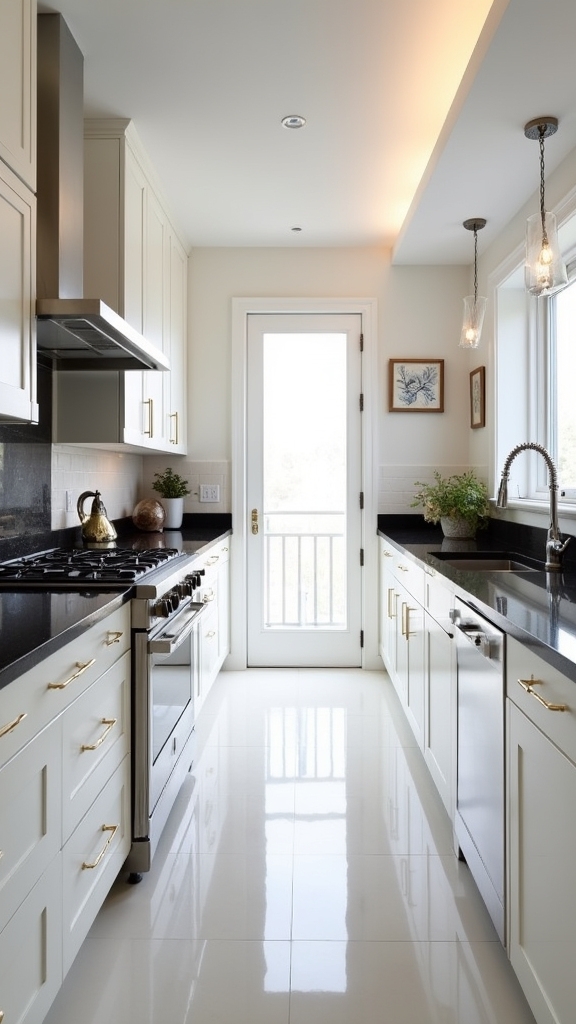
By selectively integrating metallic accents throughout a white kitchen with black countertops, designers establish visual continuity and enhance the overall aesthetic.
Cabinet hardware in brushed nickel or matte black provides a refined shift between white cabinets and dark surfaces, reinforcing a cohesive look.
Brushed nickel or matte black hardware bridges white cabinetry and dark countertops, creating a seamless and sophisticated kitchen design.
Metallic finishes on faucets and light fixtures mirror the sleek nature of black countertops, amplifying both functionality and visual appeal.
Gold or brass hardware raises elegance, introducing a warm contrast that complements the high-contrast palette.
Additionally, metallic backsplash tiles—such as shimmery black glass or textured silver—introduce depth and reflectivity, enriching the design with subtle highlights.
Finally, incorporating metallic bar stools or decorative elements unifies the space, seamlessly tying together the kitchen’s monochromatic scheme while adding sophistication and modern flair.
Frequently Asked Questions
Do Black Countertops Look Good With White Cabinets?
Black countertop designs offer visual depth and sophistication when paired with white cabinets, enhancing kitchen color schemes. Strategic cabinet hardware options, thoughtful lighting choices, and diligent countertop maintenance tips optimize this classic, high-contrast aesthetic within contemporary design principles.
How to Make a Black and White Kitchen Feel Warm?
To create a warm ambiance in a black and white kitchen, designers integrate cozy textures, warm lighting, and natural elements. Incorporating colorful accents and inviting decor enhances visual interest, ensuring the space balances high-contrast aesthetics with comfort and hospitality.
What Color Countertops Go Best in a White Kitchen?
Selecting countertop materials for a white kitchen involves evaluating color combinations, such as gray quartz, marble, or wood. Ideal kitchen design depends on style preferences, with maintenance tips suggesting lighter hues conceal debris, while darker surfaces offer dramatic visual emphasis.
How to Brighten a Kitchen With Black Countertops?
To brighten a kitchen with black countertops, designers recommend optimizing light fixtures for illumination, selecting light wall colors, incorporating reflective decorative accents, choosing sheer window treatments, and utilizing pale flooring options to enhance spatial brightness and visual balance.
Conclusion
In conclusion, white kitchens paired with black countertops exemplify the power of contrast, anchoring spaces with visual interest and timeless sophistication. Through careful consideration of materials, finishes, and textures, designers can balance warmth and modernity, ensuring a cohesive environment. Strategic use of metallic accents and layered patterns further enhances depth while maintaining clean lines. Ultimately, this high-contrast pairing showcases the enduring appeal of classic design principles fused with contemporary sensibilities for a truly refined kitchen aesthetic.

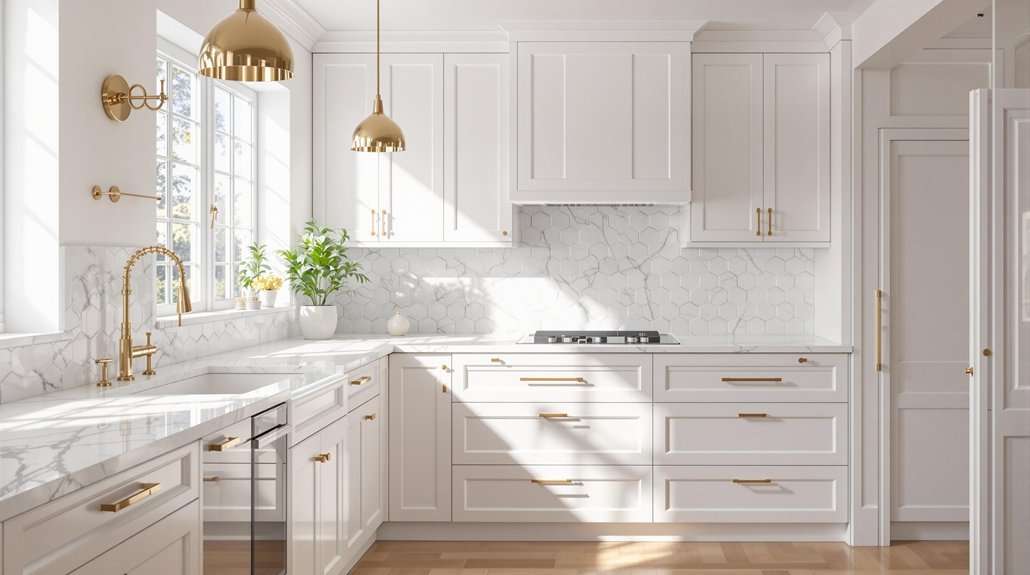
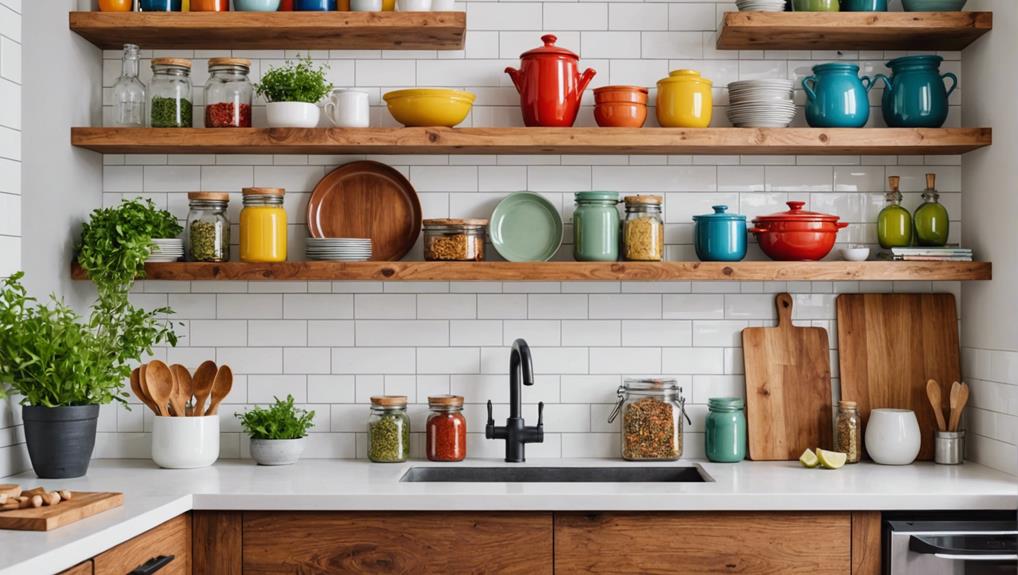
Leave a Reply